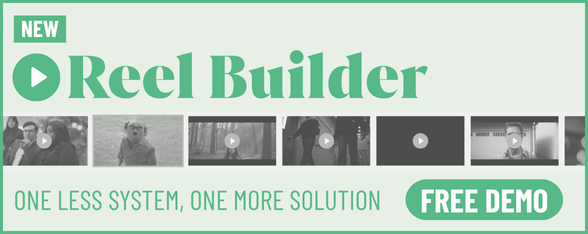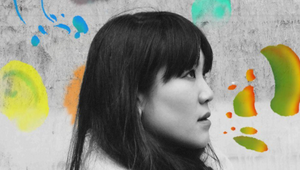
Hayley Morris on Why Stop Motion Needs Trial and Error

As far back as Hayley Morris can remember, she always had a project going on - whether it was a sketchbook, sewing, photography or making short films, her mind and hands were occupied. This was the case ever since she could hold a crayon and a piece of Play-Doh, and around the time when her mother, an artist and film lover herself, started teaching her how to draw and sculpt.
Not only did Hayley always know she wanted to be an artist - she simply was. Coming from a family of Broadway composers and musicians, she spent her early years in their home just outside of New York City, learning from everybody around her. Her grandfather, notably John Leonard Morris, the composer behind most of Mel Brooks’ films like ‘Young Frankenstein’ and ‘Blazing Saddles’, she remembers most vividly deep in his working process.
“When my grandfather wrote music, he would have a little TV on his piano and he’d come up with melodies in time with the visuals,” she says. “I loved watching his process of playing back a shot and composing music on the spot to set the mood and pacing of that particular scene.” Today Hayley does the reverse - as an animation director, part of her job is to create the visuals that come with the music.
In fact, her musical background might be the culprit for Hayley’s love of directing music videos today. Her first professional project was just that - a music video for Joker’s Daughter in collaboration with Danger Mouse. And it also happened to be Hayley’s first time creating a cut paper animation on a multiplane - a technique she still uses today in a lot of her work.
“I was so excited to be creating a music video for the first time,” she says about the experience. “I fell in love with crafting animation for a musician and being inspired by the feeling of a song. In music videos, you have a lot of freedom to explore and experiment. In this one I learned that I loved working with paper - this technique and material has evolved over the years into so many of my projects.”
Layered textures, handcrafted techniques and inventive storytelling are just a handful of the ways in which Hayley invites viewers into her visual world inspired by nature, surrealism and a mix between folklore and city-scapes. Her portfolio, as mentioned, dates way back than her start at university (The Rhode Island School of Design) and is riddled with numerous projects that prove her ability to jump between mediums, moods and references.
All of this was possible thanks to, of course, her family, but also her earliest inspirations - Jim Henson, Pee Wee, Ray Harryhausen, classical monster movies, fairy tales and good old nature. “All of these still show up in my work today in different ways. Jim Henson’s and Pee Wee’s love of puppetry, craft and original storytelling left a huge impression on me. Jim Henson’s fantastical films like ‘Labyrinth’ and ‘The Dark Crystal’ tapped into the darkness of fairy tales, while also finding moments of humour.”
The artistry in those films and in Pee Wee’s playhouse fascinated Hayley as a kid and left her wanting to live in the worlds on screen. “The same goes for Ray Harryhausen and classic monster movies,” she adds. “I also loved being outside in the woods, or spending summers by the ocean and exploring. In my work you can see all of these influences in subtle and not so subtle ways. My biggest inspirations today are Guillermo Del Toro and Bjork.”
During her university years, Hayley spent one of her summers interning at Hornet Inc. in their early days with director Peter Sluszka. He specialises in stop-motion animation, as well as commercial work. That summer, Hayley had her first real feel of the craft and its layers - she tried her hand at fabricating, animating, running all over New York and gathering materials. “I fell in love with the production process and watching Peter work with a tight-knit team. After that experience, I knew I wanted to pursue commercial directing as my career.”
And for the stop-motion part of it, Hayley says she loves how it combines mediums - something that she has been doing since way back. The possibilities in stop motion, just like in Hayley’s artistic worlds, are virtually endless. “I am a very hands-on person and love working with physical materials. For me, stop motion is the perfect mode of expression because it combines sculpting, painting, drawing, textiles, lighting, sound, etc.”
She continues, “I think when people watch stop motion, they can feel that a person made it and spent a lot of time and love creating it. I have so much respect for digital animation of course, but for me there is nothing that compares to the feeling and ‘magic’ of stop motion when you watch it.”
After leaving university, Hayley worked as a director, fabricator and animator at a production company in New York City called Curious Pictures. When not on a project, she was given the time and space to experiment, as well as the support she needed. For that reason, she looks at her experience in Curious as her ‘grad school’. “I learned so much from all the artists and producers there about how to create a project from start to finish and work with clients to articulate and execute your/their vision.”
During that time, she honed her craft by constantly creating, keeping a sketchbook and dedicating time to experimentation. “The biggest challenge in finding my voice in this process was keeping the momentum, doubt and trust in my gut.” This, and of course spending days that turned into weeks in the dark room, hunched over a project - “Especially in the summer,” she adds.
Perhaps this is where Hayley’s experimental style really took off - both in the finished product and in the way she goes through her work process. To this day, she loves trying new techniques with materials like paper, fabric, fibres, found objects, natural materials and pretty much anything you can imagine and transforming them into a story. The process always starts with plain writing of rough ideas, followed by gathering references and sketching. This is when things take a turn into the unknown - experimenting with the aforementioned materials and exploring how they work with the story helps Hayley solidify the final idea. Trial and error here is essential.
Next, is the lighting and testing of the animation. “Testing is such a crucial step in figuring out the direction of a project. In this step, I find out what works and what doesn’t in terms of colour, material restraints and movements.” After those realisations have been reached, the storyboarding can commence, followed by the fabrication, animation and edit.
While this process sounds somewhat straightforward, especially for a seasoned experimenter, working with stop motion makes any project more challenging. It could be revising designs, reshooting scenes (which is notoriously difficult when constructing one scene takes copious amounts of time and effort) or dealing with technical difficulties on a miniature scale.
One project where a lot of that took place was ‘Charlie Banana’, a piece Hayley took on when she was eight months pregnant. “Stop motion is very physical - you are usually standing for hours on end, moving tiny elements frame by frame. Animating with a giant belly bumping into things and with an aching back and feet was a challenge in itself. I overcame it by trying to stretch and wearing comfortable clothes as well as taking breaks. Now, when working on my current projects, I try to do all three of these things, because stop motion can be hard on your body, pregnant or not.”
When working with huge brands such as Samsung, McDonald’s, Toyota, The New York Times and Cadbury today, Hayley reminds herself one thing: “They came to you for a reason.” As somebody who loves the freedom of a music video and creates at their best through experimentation, she has developed a strong voice. “It’s my job to take what they like about my work and transform and adapt it into what will work for their own aesthetic and voice,” she explains. “I find this part of the job the most enjoyable - each project is a big puzzle and never the same. It’s a fun challenge to take a brief and see where you can push it beyond their initial starting point.”
The voice that Hayley has developed is both fearless and authentic, empathetic and original and still draws inspiration from folklore, fairy tales, nature and the darkness in life. “Whimsical, thoughtful and colourful,” is what she calls it, and it has been a long time in the making. “I don’t want to waiver in my vision, I just want to create.”















